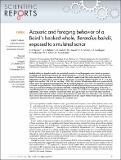Files in this item
Acoustic and foraging behavior of a Baird’s beaked whale, Berardius bairdii, exposed to simulated sonar
Item metadata
| dc.contributor.author | Stimpert, Alison | |
| dc.contributor.author | De Ruiter, Stacy Lynn | |
| dc.contributor.author | Southall, Brandon | |
| dc.contributor.author | Moretti, David | |
| dc.contributor.author | Falcone, Erin | |
| dc.contributor.author | Goldbogen, Jeremy | |
| dc.contributor.author | Friedlaender, Ari | |
| dc.contributor.author | Schorr, Greg | |
| dc.contributor.author | Calambokidis, John | |
| dc.date.accessioned | 2014-11-18T14:31:02Z | |
| dc.date.available | 2014-11-18T14:31:02Z | |
| dc.date.issued | 2014-11-13 | |
| dc.identifier | 157703663 | |
| dc.identifier | 75598466-8e58-413f-a4de-331da6148e24 | |
| dc.identifier | 84922575028 | |
| dc.identifier | 000344762200006 | |
| dc.identifier.citation | Stimpert , A , De Ruiter , S L , Southall , B , Moretti , D , Falcone , E , Goldbogen , J , Friedlaender , A , Schorr , G & Calambokidis , J 2014 , ' Acoustic and foraging behavior of a Baird’s beaked whale, Berardius bairdii , exposed to simulated sonar ' , Scientific Reports , vol. 4 , 7031 . https://doi.org/10.1038/srep07031 | en |
| dc.identifier.issn | 2045-2322 | |
| dc.identifier.uri | https://hdl.handle.net/10023/5787 | |
| dc.description | Research was supported by the US Navy Chief of Naval Operations, Environmental Readiness Program, the Office of Naval Research, the Naval Postgraduate School, and the National Research Council. | en |
| dc.description.abstract | Beaked whales are hypothesized to be particularly sensitive to anthropogenic noise, based on previous strandings and limited experimental and observational data. However, few species have been studied in detail. We describe the underwater behavior of a Baird's beaked whale (Berardius bairdii) from the first deployment of a multi-sensor acoustic tag on this species. The animal exhibited shallow (23 ± 15 m max depth), intermediate (324 ± 49 m), and deep (1138 ± 243 m) dives. Echolocation clicks were produced with a mean inter-click interval of approximately 300 ms and peak frequency of 25 kHz. Two deep dives included presumed foraging behavior, with echolocation pulsed sounds (presumed prey capture attempts) associated with increased maneuvering, and sustained inverted swimming during the bottom phase of the dive. A controlled exposure to simulated mid-frequency active sonar (3.5–4 kHz) was conducted 4 hours after tag deployment, and within 3 minutes of exposure onset, the tagged whale increased swim speed and body movement, and continued to show unusual dive behavior for each of its next three dives, one of each type. These are the first data on the acoustic foraging behavior in this largest beaked whale species, and the first experimental demonstration of a response to simulated sonar. | |
| dc.format.extent | 8 | |
| dc.format.extent | 1088853 | |
| dc.language.iso | eng | |
| dc.relation.ispartof | Scientific Reports | en |
| dc.subject | QH301 Biology | en |
| dc.subject | QA Mathematics | en |
| dc.subject.lcc | QH301 | en |
| dc.subject.lcc | QA | en |
| dc.title | Acoustic and foraging behavior of a Baird’s beaked whale, Berardius bairdii, exposed to simulated sonar | en |
| dc.type | Journal article | en |
| dc.contributor.sponsor | Office of Naval Research | en |
| dc.contributor.institution | University of St Andrews. School of Mathematics and Statistics | en |
| dc.contributor.institution | University of St Andrews. Statistics | en |
| dc.identifier.doi | 10.1038/srep07031 | |
| dc.description.status | Peer reviewed | en |
| dc.identifier.url | http://www.nature.com/srep/2014/141113/srep07031/full/srep07031.html | en |
| dc.identifier.grantnumber | N00014-12-1-0204 | en |
This item appears in the following Collection(s)
Items in the St Andrews Research Repository are protected by copyright, with all rights reserved, unless otherwise indicated.

